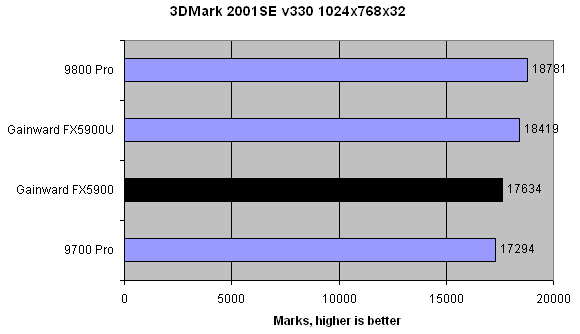3DMark 2001SE v330
3DMark 2001SE starts the ball rolling. Firstly at 1024x768x32 with no anisotropic filtering and antialiasing.

A stout showing from the slower clocked Gainward FX 5900 here. One interesting aspect is how the FX cards can't quite match the ATi cards in the traditional bandwidth-driven tests, yet do well in the GPU-bound Nature benchmark. When the slowest card in the quartet hits over 17,000 marks you know each card can run the benchmark with consummate ease.
Upping the ante with 4x FSAA and 8x anisotropic filtering.
Jumping off the benchmark track for a slight moment now. In the case of the more common multisampling antialiasing, the card takes a number of samples of a pixel, and the greater the number of samples, the greater the chances of eliminating jagged edges by blending in surrounding colours. Obviously, the greater the reads of any one pixel, the greater the toll on the card's frame buffer and memory bandwidth. Anisotropic filtering aims to provide crisper textures on sloped surfaces via sampling in a non-square fashion. Again, the greater the reads, the more accurate the texture and the greater the exertion on the card's bandwidth. We must note that NVIDIA claim to apply texture filtering to the whole screen when set to quality mode. You should now understand why cards suffer when these twin image enhancement procedures are applied.

The suffering isn't so great for the Gainward FX 5900. It seems as if the 128MB of on-board RAM is holding up well so far, as heavy AA and AF don't seem to have degraded its performance prematurely.
On to 1600x1200x32 with 4x AA and 8x AF.

The non-Ultra falls significantly behind its bigger, better equipped brother. The performance discrepancy here is down to more than just pure clock speed alone. A 50MHz GPU deficit cannot manifest itself as a 1600-mark loss. Think about the beating the framebuffer is taking with the huge textures, high resolution and copious amounts of antialiasing and anisotropic filtering. Perhaps 256MB is better in this extreme case.









